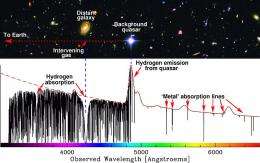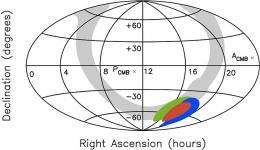Nature's laws may vary across the Universe

(PhysOrg.com) -- One of the laws of nature may vary across the Universe, according to a study published today in the journal Physical Review Letters.
One of the most cherished principles in science - the constancy of physics - may not be true, according to research carried out at the University of New South Wales (UNSW), Swinburne University of Technology and the University of Cambridge.
The study found that one of the four known fundamental forces, electromagnetism - measured by the so-called fine-structure constant and denoted by the symbol ‘alpha' - seems to vary across the Universe.
The first hints that alpha might not be constant came a decade ago when Professor John Webb, Professor Victor Flambaum, and other colleagues at UNSW and elsewhere, analysed observations from the Keck Observatory, in Hawaii. Those observations were restricted to one broad area in the sky.
However, now Webb and colleagues (PhD graduate Dr Julian King, PhD student Matthew Bainbridge and Professor Victor Flambaum at UNSW; Dr Michael Murphy at Swinburne University of Technology, and Professor Bob Carswell from Cambridge University) have doubled the number of observations and measured the value of alpha in about 300 distant galaxies, all at huge distances from Earth, and over a much wider area of the sky. The new observations were obtained using the European Southern Observatory's ‘Very Large Telescope' in Chile.
"The results astonished us," said Professor Webb. "In one direction - from our location in the Universe - alpha gets gradually weaker, yet in the opposite direction it gets gradually stronger."

"The discovery, if confirmed, has profound implications for our understanding of space and time and violates one of the fundamental principles underlying Einstein's General Relativity theory," Dr King added.
"Such violations are actually expected in some more modern ‘Theories of Everything' that try to unify all the known fundamental forces," said Professor Flambaum. "The smooth continuous change in alpha may also imply the Universe is much larger than our observable part of it, possibly infinite."
"Another currently popular idea is that many universes exist, each having its own set of physical laws," Dr Murphy said. "Even a slight change in the laws of Nature means they weren't ‘set in stone' when our Universe was born. The laws of Nature you see may depend on your ‘space-time address' - when and where you happen to live in the Universe."
Professor Webb said these new findings also offer a very natural explanation for a question that puzzled scientists for decades: why do the laws of physics seem to be so finely-tuned for the existence of life?
"The answer may be that other regions of the Universe are not quite so favourable for life as we know it, and that the laws of physics we measure in our part of the Universe are merely ‘local by-laws', in which case it is no particular surprise to find life here," he said.
More information: A pre-print version is available at arXiv:1008.3907.
Provided by Swinburne University of Technology





















